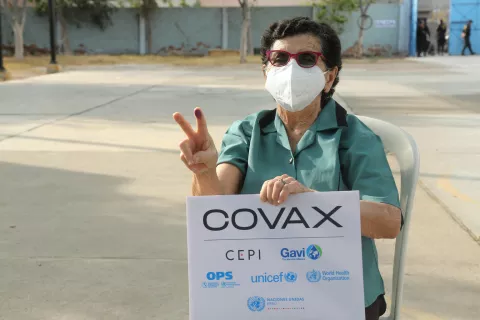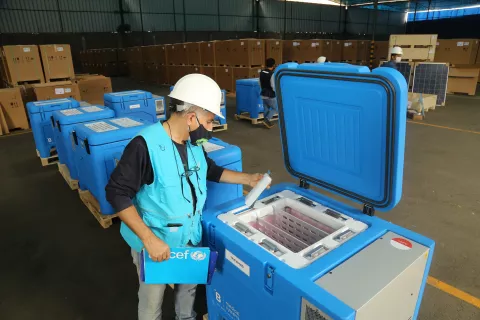Peru’s mental health pivot helps youth cope during COVID-19
Community-based care equips young people, like Andre, to make their own changes

- Available in:
- Español
- English
“Someday I’d like to make a big change in this society. I’m open-minded and I think I could adapt to any situation,” said Andre*, 14 years old, as he looked towards the hills on the northern outskirts of Lima, Peru, where he shares a small room with his mother Roxana* in his aunt’s house.
A few months before the pandemic, Roxana got a call from Andre’s school.
“I’ll never forget that day. He was under a desk, crying, and saying that he didn’t want to keep living.”
Roxana sought care at hospitals and private clinics, but they were either too far away or too expensive. It wasn’t until they signed up for public health insurance at the local health centre that they got a referral to the Community Mental Health Centre in Carabayllo, a 10-minute bus ride from home.

Integrated care, all in one place
Set up in a repurposed sports stadium and staffed with a multi-disciplinary team, the centre provides specialized care for people with moderate to severe mental health conditions, as well as prevention services. Diagnosed with anxiety and depression, rooted in part in his parents’ separation, Andre started meeting with the centre’s psychologist, psychiatrist, nursing staff and social worker for therapy.


“We made an integrated plan to help him understand and manage what he’s going through,” said psychologist Yesica Chambilla. “We provide him with tools to make his own changes.”
They also provide guidance to Roxana, who plays an active role in his care.
Psychiatrist Dr. Maria Saire highlights that:
“The community-based model keeps people closer to their families and the community’s wider network of support.”
From the hospital to the community
Until recently, Peru’s mental health care system was concentrated in three psychiatric hospitals in Lima. In 2013, the Ministry of Health estimated that 1 in 5 people in Peru had mental health conditions and that just 1 in 5 of those in need of care received it.
These service gaps, along with advocacy from the Ombudsperson’s Office, prompted a series of reforms to expand community-based care: adding mental health care coverage to the national health insurance scheme in 2013, establishing a mental health results-based budget programme1 in 2014 that helped boost public spending, and passing a new national mental health law in 2019.2 As a result, Peru’s network of community-based mental health care increased from 22 to 203 centres between 2015 and 2021. The centres are complemented by 30 specialized units in general hospitals and 48 halfway houses.3

“Looking ahead, there are two important challenges,” said Dr. Yuri Cutipé, Executive Director, Mental Health, Ministry of Health. “One, continuing to expand community-based services while ensuring the same quality across the country; and two, developing specific programmes for vulnerable populations as a part of a multisectoral approach.”
COVID-19’s mental toll
The pandemic put Peru’s mental health services to the test. According to an online survey conducted by the Ministry of Health and UNICEF in 2020, a third of children and adolescents experienced socio-emotional difficulties during the pandemic in Peru,4 where the government imposed a 106-day national lockdown that left many adults, including Roxana, temporarily unemployed and young people, including Andre, confined at home. The demand for mental health services increased.
To help address adolescent needs, the Ministry of Health, with UNICEF’s support, released technical guidelines for the comprehensive mental health care of adolescents in 2021,5 as well as specific guidance for the COVID-19 context in 2020.6 Between December 2020 and April 2021, the Ministry also piloted, with UNICEF and the NGO CEDAPP, a free mental health hotline for adolescents and their families that reached 821 people dealing with anxiety, depression and family problems.7
Not giving up
While the lockdown was stressful for Andre, he also credits it in part with his recovery: “The pandemic helped me instead of making things worse.” Andre spoke regularly with his psychologist by phone and spent more time with his mother and her family.

“I made up for lost time with my son,” said Roxana, who before the pandemic would only see Andre at night after returning home from work on the other side of the city.
More than a year after his first visit to the centre, Andre is experiencing positive changes.
“Before coming, things were really bad. I felt sick and didn’t want to eat. Now I feel much better, and I don’t want to give up.”


When he graduates, Andre, whose interests range from biology to music and poetry, plans to study zoology outside Peru. “If I don’t get a scholarship to go abroad, I’ll study something technical like IT first while I save up,” he said, recognizing the challenges he faces but also open to the possibilities ahead.
_____________________________________________________________________________
1 Peru Ministerio de Salud, Programa Presupuestal 0131 Control Y Prevención En Salud Mental: ANEXO N° 2 Contenidos Mínimos del Programa Presupuestal, Ministerio de Salud, Lima, 2021, <www.minsa.gob.pe/presupuestales/doc2021/ANEXO2_9.pdf>, consultado el 2 de agosto de 2021.
2 Perú, Ley de Salud Mental, 22 May 2019, <www.gob.pe/institucion/congreso-de-la-republica/normas-legales/1423694-30947>, consultada el 2 de agosto de 2021.
3 Peru Ministerio de Salud, ‘Centros de Salud Mental Comunitaria (CSMC)’, <www.minsa.gob.pe/salud-mental>, consultado el 2 de agosto de 2021.
4 Ministerio de Salud y Fondo de las Naciones Unidas para la Infancia, ‘La Salud Mental de Niñas, Niños y Adolescentes en el Contexto de la COVID-19. Estudio en Línea. Perú 2020’, Ministerio de Salud, Lima, April 2021, <www.unicef.org/peru/informes/salud-mental-ninas-ninos-adolescentes-contexto-covid-19-estudio-en-linea-peru-2020>, consultado el 26 de julio de 2021.
5 Ministerio de Salud y Fondo de las Naciones Unidas para la Infancia, ‘La Salud Mental de Niñas, Niños y Adolescentes en el Contexto de la COVID-19. Estudio en Línea. Perú 2020’, Ministerio de Salud, Lima, Abril 2021, <www.unicef.org/peru/informes/salud-mental-ninas-ninos-adolescentes-contexto-covid-19-estudio-en-linea-peru-2020>, consultado el 26 de julio de 2021.
6 Ministerio de Salud, ‘Documento Técnico: Orientaciones Técnicas para el Cuidado Integral de Salud mental de la Población Adolescente’, Resolución Ministerial N° 753-2021-MINSA, 12 de junio de 2021. <www.gob.pe/institucion/minsa/normas-legales/1963209-753-2021-minsa>, consultado el 2 de agosto de 2021.
7 Fondo de las Naciones Unidas para la Infancia, ‘Adolescentes cuentan con línea telefónica gratuita de apoyo y orientación emocional’, Nota de prensa, UNICEF, Lima, 18 de diciembre de 2020, <www.unicef.org/peru/comunicados-prensa/adolescentes-linea-telefonica-gratuita-apoyo-orientacion-emocional>, consultado el 15 de junio de 2021.


